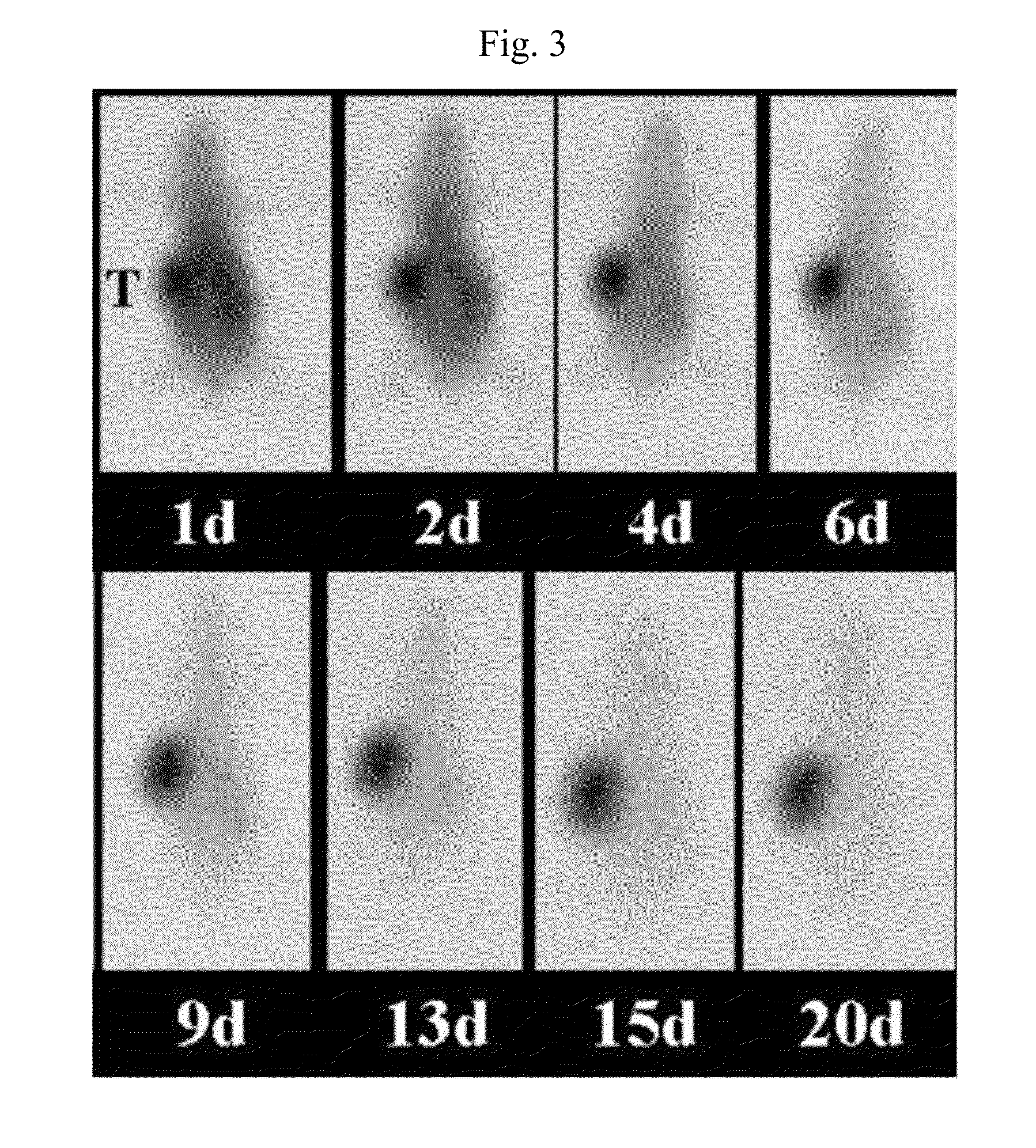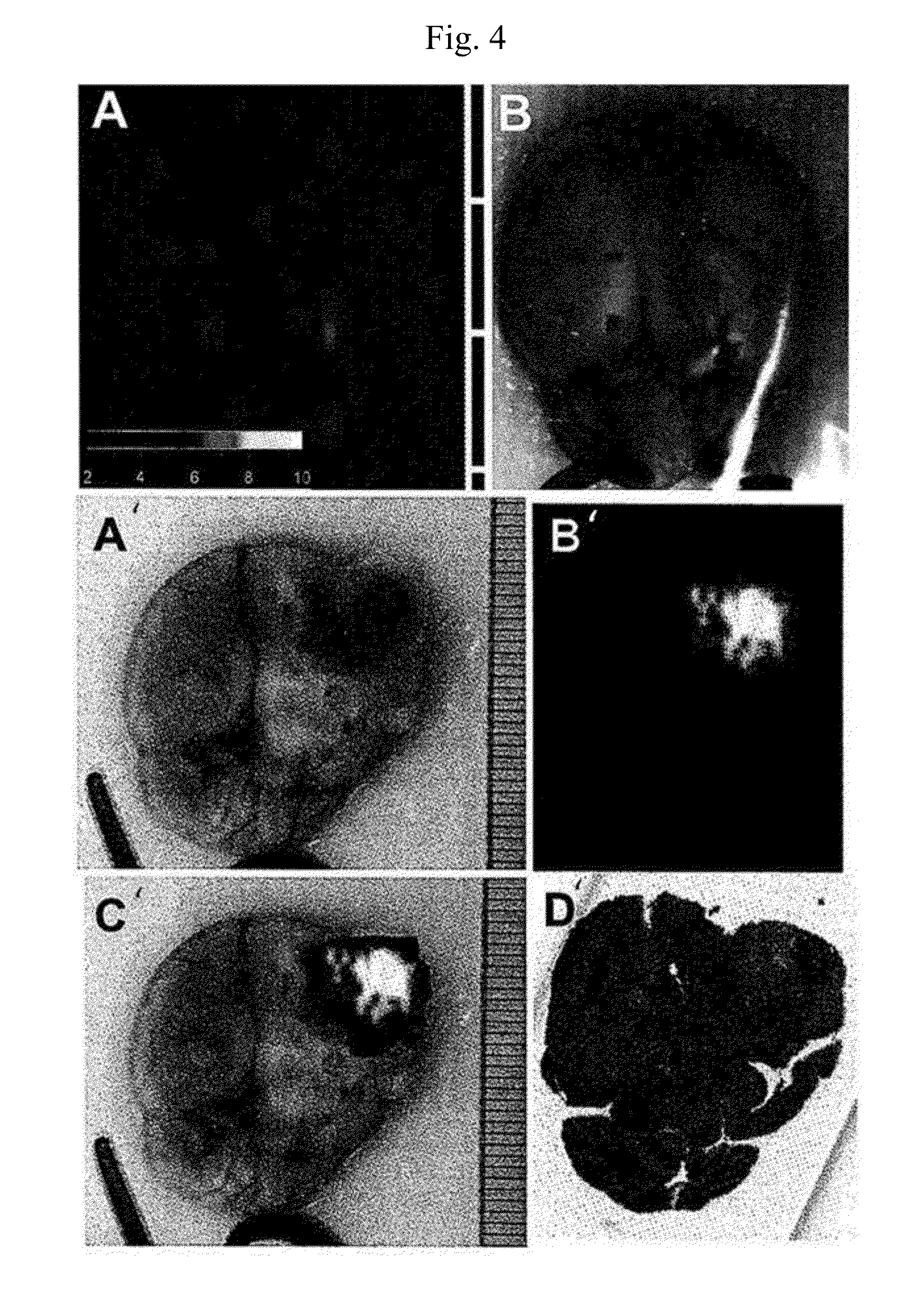Phospholipid ether analogs as cancer-targeting drug vehicles
a technology of phospholipid ether and cancer, applied in the direction of group 5/15 element organic compounds, organic chemistry, drug compositions, etc., can solve the problems of cancer formation, benign tumors are incapable of crossing natural boundaries between tissue types, and the troublesome type of brain cancer is brain cancer. to prevent metastasis and recurrence
- Summary
- Abstract
- Description
- Claims
- Application Information
AI Technical Summary
Benefits of technology
Problems solved by technology
Method used
Image
Examples
example 1
Syntheses of Conjugates
[0200]
I. Synthesis of CLR1601
A. Synthesis of CLR1401 Azide
[0201]18-(p-Iodophenyl)octadecyl phosphocholine (4.01 g, 6.3 mmol), sodium azide (818 mg, 12.6 mmol) and sodium ascorbate (140 mg, 0.71 mmol) were dissolved in the mixture of degassed ethanol (28 ml) and water (12 ml) in the reaction vessel. Copper (I) iodide (120 mg, 0.63 mmol) and N,N′-dimethyl-ethylenediamine (0.1 ml, 0.94 mmol) were added to the reaction mixture. Reaction vessel was tightly closed and the mixture was stirred at 80° C. for 45 min. Reaction mixture was cooled to the room temperature, water (60 ml) was added, and the mixture was stirred for 30 min open to the air. The mixture was transferred to the separatory funnel, chloroform (80 ml) and methanol (52 ml) were added, and extraction was performed by shaking. Chloroform layer was removed, and extraction was repeated (2×80 ml of chloroform). Combined chloroform extracts were washed with 0.01 N HCl, dried over Na2SO4, filtered and evapora...
example 2
CLR1501 is Preferentially Sequestered by Cancer Cells Via Lipid Rafts
Materials and Methods
[0223]PC-3 cells were pretreated with either 2 μg / ml filipin III or vehicle for 15 min, then washed and incubated with 2 μCi of 125I-CLR1404 for 1 h. The media was removed and the cells were washed with phosphate buffered saline containing 0.1% bovine serum albumin, trypsinized, then split into two samples for determination of cell number by DNA content (A280 compared to a cell line specific standard curve) and counts per minute using a Gamma Counter (Perkin Elmer).
Results:
[0224]Pretreatment of PC-3 cells with filipin III, an agent that sequesters cholesterol and disrupts lipid rafts, resulted in nearly 40% less uptake of 125I-CLR1404 compared to untreated control cells (FIG. 1). This supports the hypothesis that CLR1404 uses lipid rafts as portals of entry into cancer cells. Notably, higher filipin III concentrations are cytotoxic, and therefore, complete lipid raft ablation (and presumably co...
example 3
Preferential Uptake of CLR-1501 by Cancer Cells Over Healthy Cells
Materials and Methods
[0225]Human cancer cell lines were purchased from the American Type Culture Collection (ATCC). They included the following: Caki-2 (renal; clear cell carcinoma), HCT-116 (colorectal carcinoma); MES-SA / Dx5 (uterine sarcoma) [all maintained in McCoy's 5a medium supplemented with 10% fetal bovine serum (FBS)], Ovcar-3 (ovarian adenocarcinoma) [maintained in RPMI medium supplemented with 20% FBS], U87-MG (glioma) [maintained in minimum essential medium supplemented with 10% FBS], Mia Paca-2 (pancreatic carcinoma) (maintained in Dulbecco's modified Eagle's medium supplemented with 10% FBS), PC-3 (prostate carcinoma) (maintained in F-12K medium supplemented with 10% FBS), MDA-MB-231 (triple-negative mammary gland adenocarcinoma) (maintained in Leibovitz's medium supplemented with 10% FBS), and A549 (non-small cell lung carcinoma) (maintained in F-12 medium supplemented with 10% FBS). Normal human skin f...
PUM
| Property | Measurement | Unit |
|---|---|---|
| size | aaaaa | aaaaa |
| temperature | aaaaa | aaaaa |
| temperature | aaaaa | aaaaa |
Abstract
Description
Claims
Application Information
 Login to View More
Login to View More - R&D
- Intellectual Property
- Life Sciences
- Materials
- Tech Scout
- Unparalleled Data Quality
- Higher Quality Content
- 60% Fewer Hallucinations
Browse by: Latest US Patents, China's latest patents, Technical Efficacy Thesaurus, Application Domain, Technology Topic, Popular Technical Reports.
© 2025 PatSnap. All rights reserved.Legal|Privacy policy|Modern Slavery Act Transparency Statement|Sitemap|About US| Contact US: help@patsnap.com



